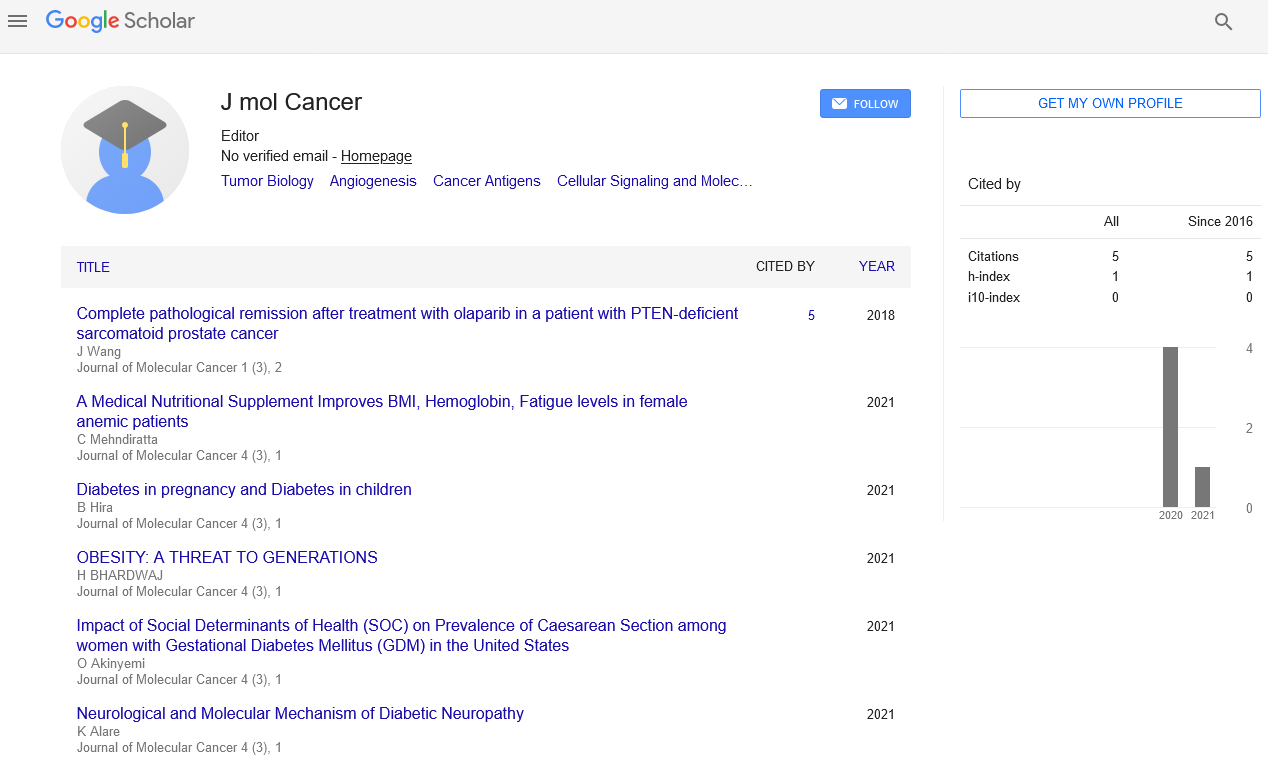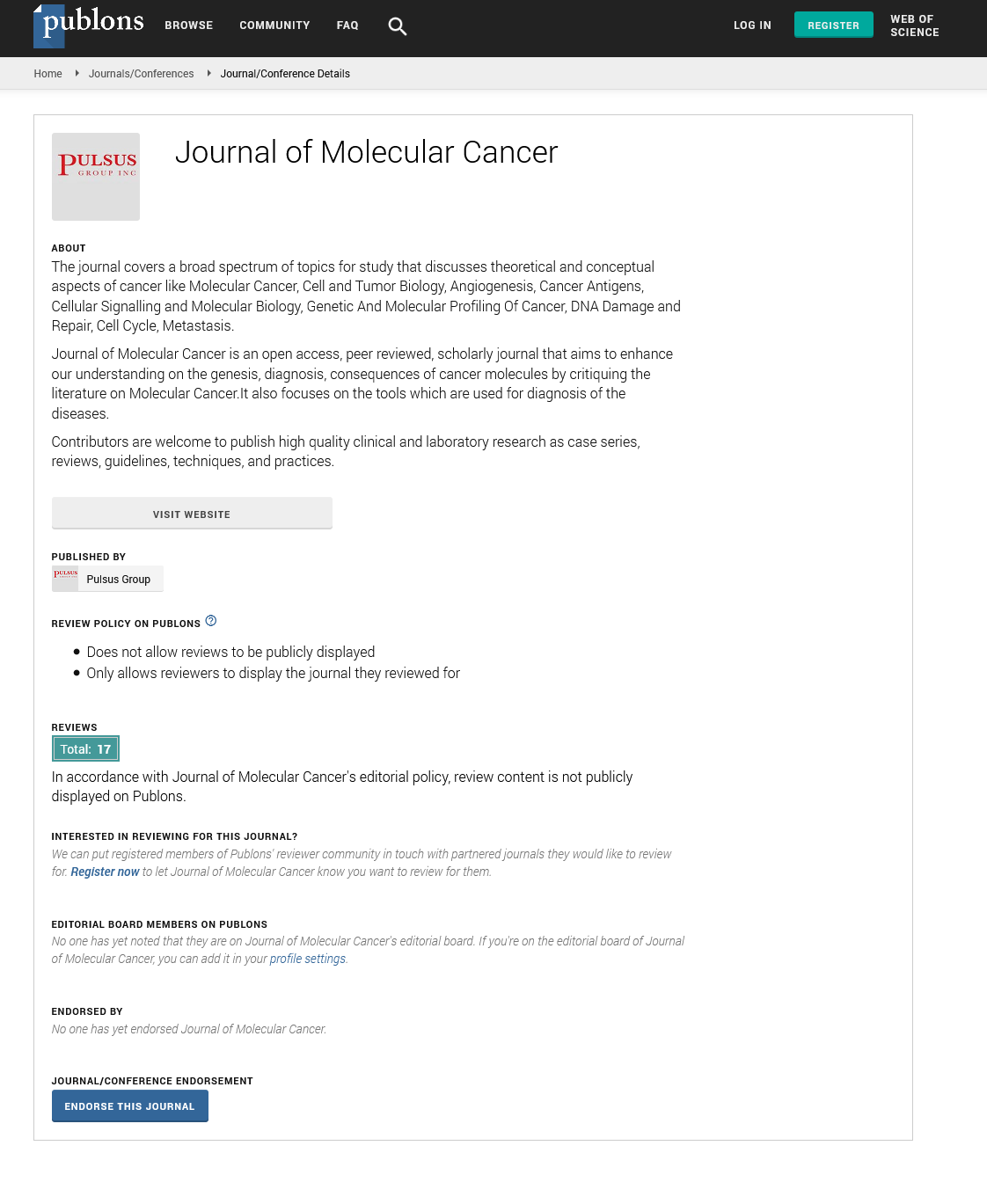RNA interference: Silencing specific genes
Received: 14-Mar-2022, Manuscript No. puljmc-22-4484; Editor assigned: 16-Mar-2022, Pre QC No. puljmc-22-4484(PQ); Accepted Date: Mar 14, 2022; Reviewed: 21-Mar-2022 QC No. puljmc-22-4484(Q); Revised: 25-Mar-2022, Manuscript No. puljmc-22-4484(R); Published: 28-Mar-2022, DOI: DOI:10.37532/puljmc.22.5(2).12-13
Citation: Emily C. RNA interference: silencing specific genes. J Mol Cancer. 2022; 5(2):12-13.
This open-access article is distributed under the terms of the Creative Commons Attribution Non-Commercial License (CC BY-NC) (http://creativecommons.org/licenses/by-nc/4.0/), which permits reuse, distribution and reproduction of the article, provided that the original work is properly cited and the reuse is restricted to noncommercial purposes. For commercial reuse, contact reprints@pulsus.com
Abstract
Pancreatic malignant growth is anticipated to be the subsequent driving reason for disease related passing by 2025. The best chemotherapy just broadens endurance by a normal of 18 weeks. The broad fibrotic stroma encompassing the growth checks helpful choices as chemotherapy drugs can't unreservedly infiltrate the cancer. RNA impedance (RNAi) has arisen as a promising way to deal with reform malignant growth treatment. Little meddling RNA (siRNA) can be intended to restrain the statement of any quality which is significant given the serious level of hereditary heterogeneity present in pancreatic growths. In spite of the capability of siRNA treatments, there are obstacles restricting their clinical application like unfortunate vehicle across natural hindrances, restricted cell take-up, corruption, and fast leeway. Nanotechnology can address these difficulties. As a matter of fact, the beyond couple of many years have seen the conceptualization, plan, pre-clinical testing and late clinical endorsement of a RNAi nanodrug to treat illness. In this survey, we remark on the present status of play of clinical preliminaries assessing siRNA nanodrugs and audit preclinical examinations exploring the adequacy of siRNA therapeutics in pancreatic malignant growth. We evaluate the physiological obstructions extraordinary to pancreatic malignant growth that should be viewed as while planning and testing new nanomedicines for this sickness.
Key Words
Chemoresistance; siRNA-nanotherapeutics; RNAi-nanoparticles
Introduction
One of the characterizing histopathological highlights of PC is the profoundly fibrotic stroma that can establish over 80% O of the growth mass. Critically, a higher stromal content in human PC patients is related with unfortunate endurance result. This desmoplastic response brings about the affidavit of a strangely thick organization of extracellular network proteins around growth components, which packs and misshapes cancer veins and goes about as an actual obstruction to chemotherapy drug conveyance. Also, this unusual vasculature drives hypoxia in PC cancers which advances the improvement of chemoresistance. This thick fibrosis is delivered by malignant growth related Pancreatic Stellate Cells (PSCs) which are regularly in a tranquil structure in sound pancreas however are selected by PC cells where a cross-talk system powers the forcefulness of PC. For sure, PSCs are currently viewed as key cell restorative focuses to reinvent the fibrosis in PC and furthermore to hinder the bidirectional supportive of tumorigenic flagging that exists with disease cells. It is in this way basic to think about both the cancer and its encompassing stroma while planning novel remedial systems for PC. In such manner, there has been serious exploration to attempt to outfit the force of the RNA obstruction (RNAi) quality hushing instrument in both growth cells and stromal cells to restoratively restrain cancer advancing qualities.RNAi atoms including little meddling RNA (siRNA) can be intended to quiet the statement of qualities whose proteins are thought of as challenging to hinder utilizing compound specialists or monoclonal antibodies. This innovation offers the valuable chance to focus on a mixed drink of cancer advancing qualities in various cell types present in the growth microenvironment. Be that as it may, notwithstanding the capability of siRNA-based treatments, the test of conveyance and arrival of siRNA into cells are hindrances which thwart its full clinical potential.
Challenges and opportunities in pancreatic cancer
One of the most characterizing and novel elements of PC are the profoundly fibrotic stroma that encompasses and packs cancer components. We currently have a reasonable arrangement that the stroma is a central member in advancing PC movement, chemoresistance and metastasis. Accordingly, it is basic to address the job of the stroma while planning new nanotherapeutics for PC. Stroma-rich strong cancers, for example, PC create elevated degrees of strong and liquid pressure as well as thick extracellular network. For sure, flawed cancer veins bring about expanded Interstitial Liquid Strain (IFP), and this is additionally exacerbated by the packed lymphatic vessels that don't permit satisfactory liquid seepage. As needs be, cancer IFP becomes similar to the microvascular pressure in this manner easing the strain slope between the veins and the growth. In a GEMM of PC, IFP was shown to be just about 10-crease higher in PC growths contrasted with ordinary pancreas. Accordingly, latent dissemination turns into the primary transvascular transport system for nanoparticles into the growth. Considering that the pace of dispersion is conversely corresponding to the size of the nanoparticle, bigger nanoparticles are impeded from diffusing and entering strong growths. Reliable with this examination, most of fruitful RNAi-nanoparticles tried in orthotopic PC mouse models are inside a size scope of 17-60 nm. Great gathering and viability was exhibited in chemotherapy-stacked micelles going in size from 30 to 100 nm in the colorectal disease mouse model, while just the 30 nm micelles had unrivaled aggregation and against cancer impacts contrasted with bigger micelles (70 and 100 nm) in the orthotopic PC mouse model.
Conclusion
The possibility to quietness any growth advancing quality with RNAi-nanotherapeutics holds guarantee for PC treatment. This has been shown by a few progressed pre-clinical investigations that have exhibited critical enemy of growth, chemosensitizing and hostile to metastatic impacts with siRNA-nanotherapeutics. Nonetheless, before these promising discoveries can be meant the center, we want to inspect these nanomedicines in pre-clinical models that precisely mirror the science of human PC. This incorporates orthotopic PC mouse models with a flawless and useful fibrotic stroma, hereditarily designed mouse models with a useful resistant framework as well as complicated 3D in vitro and ex vivo models of the infection. For instance, multicellular culture of cancer spheroids in microfluidics gadgets can reiterate numerous microenvironmental prompts, for example, raised IFP, and can along these lines be an exceptionally valuable instrument in the pre-clinical advancement of siRNA-nanotherapeutics. Assuming that these models can be planned with high throughput capacities, nanoparticles with various siRNA targets can be tried on quiet cancer tests to direct a customized medication program. These models, utilized in corresponding with clinically significant in vivo models, can educate the plan regarding new nanoparticles. It is important to address the novel pathophysiology of PC, and specifically the fibrotic stroma which presents a few boundaries for nanoparticle conveyance. On the science front, solid thought should be given for creating techniques that can deliver enormous scope and reproducible measures of clinical grade nanomaterials. Assuming we are to alter the treatment of PC, it is basic to construct more grounded joint efforts between scientists, researcher and clinicians, as this will eventually prepare for a customized medication technique for PC utilizing siRNA-nanoparticles to restrain target qualities that are extraordinary to a patient's cancer.






